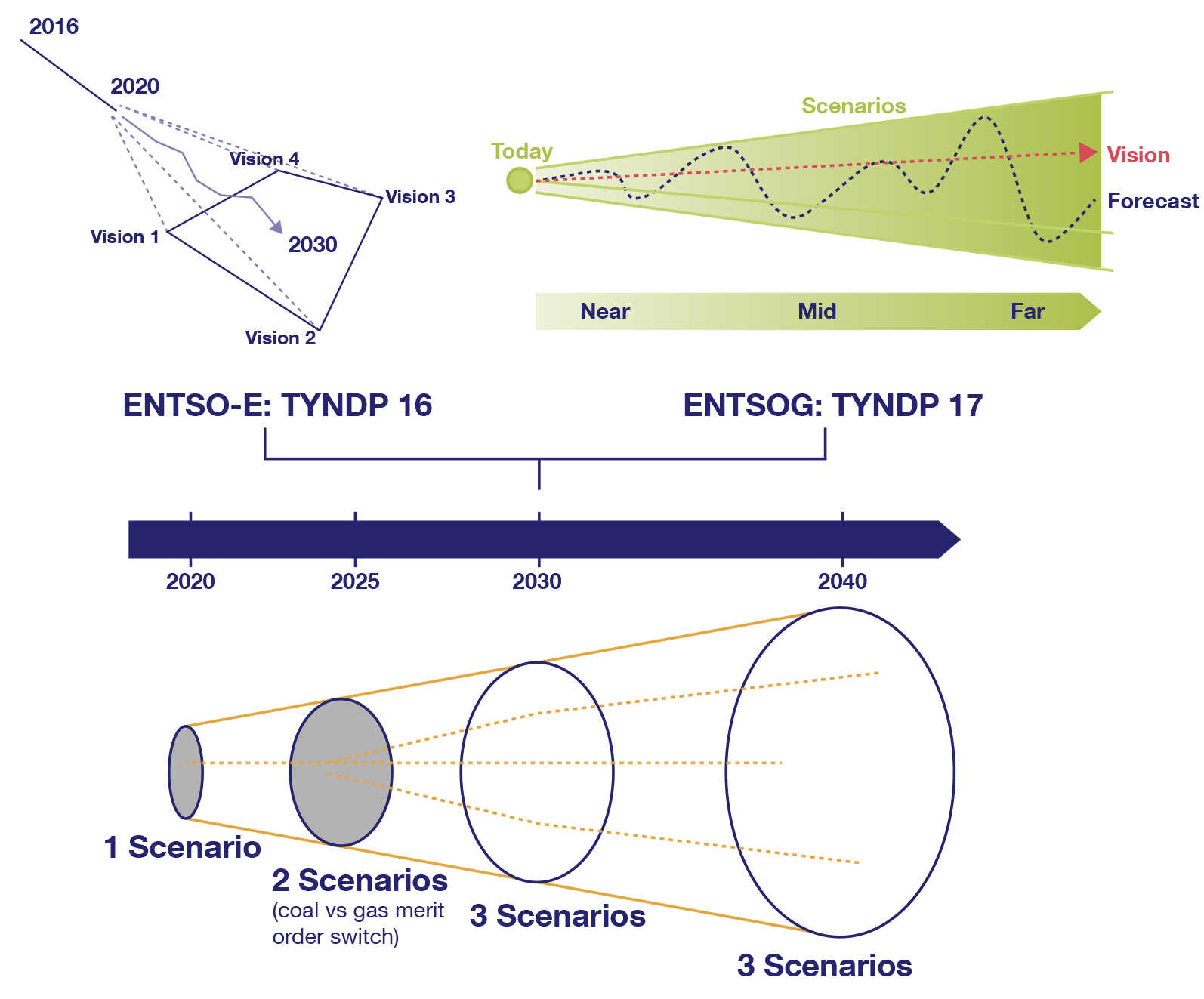Improvements for TYNDP18
Both ENTSOs consistently work to modernise their data, tools and methodologies between each release of the scenarios. For TYNDP 2018, some of the key improvements are presented below. The methodologies used by both ENTSOs to produce the scenarios are presented in detail in the Annex of this report.
Looking at gas and electricity from the same angle
For the first time, the ENTSOs for gas and electricity have pooled their efforts and expertise to provide a set of scenarios allowing decisions to be made on the European energy sector based on consistent analysis between the sectors.
Together, the ENTSOs decided to: – develop joint scenarios, instead of adopting data from visions created separately, without common storylines or input. – Increase stakeholder interaction across a wider section of the energy industry when developing the scenarios. – Include cross-sectoral technologies.
This is an important change since both gas and electricity sectors are both impacted by the same transition towards decarbonisation and developments in one sector can affect the other. For example: – The decarbonisation of the domestic heating sector (conversion of fossil fuel heating to electric heat pump heating or hybrid heat pump heating) increases electricity consumption and decreases gas consumption in the residential and commercial sectors. – Changes to gas-fired power plants fuel consumption due to electricity production from renewable energy sources. – Developments within P2G: production of green gas, utilisation of surplus renewable electricity.
A consistent but diverse family of scenarios
The new set includes more scenarios for the long term (2030 and 2040) than for the near to mid-term. This reflects the growing level of uncertainty as the future develops.
The TYNDP 2018 electricity sector assumptions and results come from a balanced mix between top-down and bottom-up approaches (see section 5.2 for further explanations). This allows the combination of local knowledge and experience of TSOs in predicting the near future, with the necessity to deliver long-term scenarios driven by a shared European vision.

Figure 22: TYNDP 2018 scenario framework
Measuring the effect of climate on the power system
For the first time, the electricity mix in each scenario is assessed using 3 different climate situations. For each hour of the year and in each zone of the model (countries or parts of countries), a database constructed with the expertise of Météo-France and the Technical University of Denmark provided data for precipitation, wind, temperature and sun exposition. This was used to determine locally the RES generation as well as demand levels. The ENTSO’s experts selected 3 series of weather conditions representing warmer or colder and dryer or wetter years and tested them in the models. With a high share of solar and wind energy in the scenarios, it is increasingly important to better understand how the system responds to warmer or colder years, or to weaker or steadier winds.
Improving the modelling of demand
ENTSO-E and ENTSOG have both focused on improving the prediction of energy consumption. New approaches and algorithms were developed to more precisely forecast the penetration of electricity demand side technologies (including demand response, electric vehicles, heat pumps and home storage). These served as input to determine specific load profiles for each zone, scenario and climate condition. The gas demand data for scenarios now includes a sectoral breakdown for all countries.
Thanks to the new level of collaboration between ENTSOG and ENTSO-E, the output of electricity models now directly serves as an input for the gas scenarios power sector consumption profiles.
For TYNDP 2017, ENTSOG developed a gas for power generation methodology called the ‘Thermal Gap’ approach, aligning with specific ENTSO-E TYNDP 2016 Visions and using this data as an input. The installed capacity and generation data of coal and gas plants were used to create a ‘Thermal Gap’, which depending on the storyline would either be dominated by gas or coal by flexing the production between each fuel source to meet the required generation. As a result, although the overall generation values were the same, the share from gas or coal would differ compared with the ENTSO-E Visions.
In the electricity sector the development of renewable energy sources that have started over past years will see a tremendous evolution in the future. Also the demand for electricity is expected to develop significantly in sectors currently not massively electrified, such as heating or transport.
In the gas sector, significant changes are expected in the demand pattern, with the role of gas expected to decrease in the heating sector but to develop in parts of the transport sector. In terms of supplies, the gas sector is also expected to experience a development of renewable gas sources, produced within the European borders, that will be complemented by the gas supplies coming from extra-EU supply sources